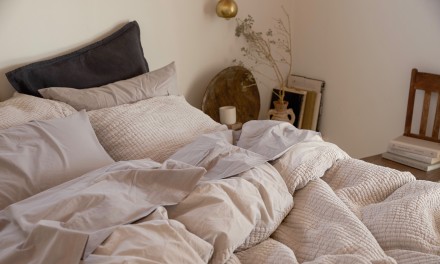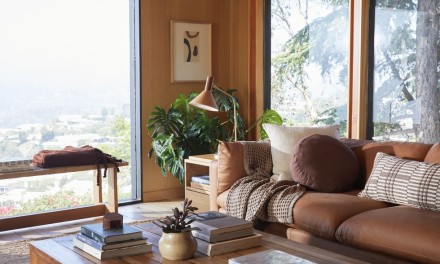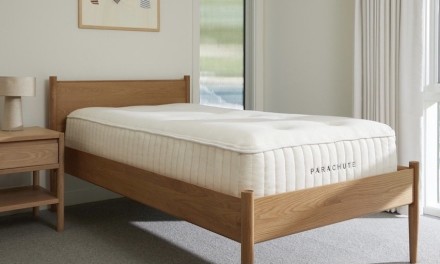When we set out to create the perfect sleep experience, we knew it would depend on one core factor: Fabric. The chosen textiles and bedding materials would need to possess the power to relax the mind and put the body at ease, to beckon you to bed each night and return you to the world rejuvenated the next morning. We visited factories all over the world in search of this perfect product and sensation, and when we first set foot in our factory in Portugal, we knew we'd found it. This facility is manufactured by true artisans who have been making world class bedding for over 80 years. Their passion for linens is demonstrated in their attention to detail and impeccable craftsmanship.
Parachute's bedding fabrics and materials are carefully selected and thoughtfully crafted to deliver the most restful sleep possible. And we share the best ways to style like a pro. From percale, sateen, linen and brushed cotton to down and down alternative, we carry all the best materials for bed sheets, pillowcases, duvet covers and inserts.
What is Percale?
Percale is most easily comparable to the perfect white button-down: Crisp, clean and livable. It's garment washed for ultimate comfort and will only become softer as it's laundered. This fabric is also durable and versatile, making it one of the best bed sheet materials you can buy.
What is Percale?
Percale is most easily comparable to the perfect white button-down: Crisp, clean and livable. It's garment washed for ultimate comfort and will only become softer as it's laundered. This fabric is also durable and versatile, making it one of the best bed sheet materials you can buy.
How is percale made?
Parachute's Percale and Sateen bedding materials are made using the finest long-staple Egyptian cotton, combed with precision to remove all impurities and dyed naturally in a process that surpasses the highest safety and environmental protection standards.
Its tightly woven weave – accomplished in a classic one-thread-over-one-under fashion – gives the fabric a simple, matte finish while providing ultra breathability. Cool to the touch, Percale fabric is perfect for all seasons and is especially forgiving during the balmy summer months.
How is percale made?
Parachute's Percale and Sateen bedding materials are made using the finest long-staple Egyptian cotton, combed with precision to remove all impurities and dyed naturally in a process that surpasses the highest safety and environmental protection standards.
Its tightly woven weave – accomplished in a classic one-thread-over-one-under fashion – gives the fabric a simple, matte finish while providing ultra breathability. Cool to the touch, Percale fabric is perfect for all seasons and is especially forgiving during the balmy summer months.
Pros and Cons of Percale
The best bed sheets for you might not be the right option for someone else. With that said, it's good to review the benefits and potential drawbacks of percale before ordering your bedding.
Percale bed sheets are smooth, crisp and cool to the touch with a deluxe, high-end appeal. The naturally moisture-wicking material is lightweight and breathable. And though it's strong and durable, it doesn't trap heat. Plus, our percale sheets are easy to care for as they are machine washable!
These non-insulating qualities make percale one of the best cooling sheets. While it's great for year-round use, percale isn't as warm as other bedding fabrics and wrinkles more easily.
Pros and Cons of Percale
The best bed sheets for you might not be the right option for someone else. With that said, it's good to review the benefits and potential drawbacks of percale before ordering your bedding.
Percale bed sheets are smooth, crisp and cool to the touch with a deluxe, high-end appeal. The naturally moisture-wicking material is lightweight and breathable. And though it's strong and durable, it doesn't trap heat. Plus, our percale sheets are easy to care for as they are machine washable!
These non-insulating qualities make percale one of the best cooling sheets. While it's great for year-round use, percale isn't as warm as other bedding fabrics and wrinkles more easily.
Is percale right for you?
If you live in a warm climate or tend to get hot at night, there's a good chance you'll fall in love with percale. It's got that crisp, smooth hotel-bedding vibe and gets softer with every wash. The breathable material allows air to pass through. Plus it wicks away moisture while you comfortably slumber.
Is percale right for you?
If you live in a warm climate or tend to get hot at night, there's a good chance you'll fall in love with percale. It's got that crisp, smooth hotel-bedding vibe and gets softer with every wash. The breathable material allows air to pass through. Plus it wicks away moisture while you comfortably slumber.
What is sateen?
Sateen, on the other hand, is a more lustrous experience. Its unique weave – four-over-one-under – gives this material the sheen and drape of satin with the comfort and durability of our world-class cotton.
Ultra smooth to the touch, Sateen fabric feels luxurious against your skin and comfortable any time of the year. Our Sateen bedding is finished with a signature double stitch tipping, giving it a distinguished look.
What is sateen?
Sateen, on the other hand, is a more lustrous experience. Its unique weave – four-over-one-under – gives this material the sheen and drape of satin with the comfort and durability of our world-class cotton.
Ultra smooth to the touch, Sateen fabric feels luxurious against your skin and comfortable any time of the year. Our Sateen bedding is finished with a signature double stitch tipping, giving it a distinguished look.
How is sateen made?
Sateen is created with the slightly complex satin weave structure mentioned above. But unlike satin, the fabric is woven from spun yarns.
The sateen you’ll find at Parachute is made from 100% long-staple Egyptian cotton. With the softness of premium cotton and the smoothness of satin, it's easy to see why sateen is a top choice for bedding materials.
How is sateen made?
Sateen is created with the slightly complex satin weave structure mentioned above. But unlike satin, the fabric is woven from spun yarns.
The sateen you’ll find at Parachute is made from 100% long-staple Egyptian cotton. With the softness of premium cotton and the smoothness of satin, it's easy to see why sateen is a top choice for bedding materials.
Pros and Cons of Sateen
Smooth, soft, sturdy and resistant to pilling, there's much to appreciate about sateen. Many like that it's sleek and drapey like satin, but with a subtle sheen instead of a shiny appearance. While sateen can be a little spendier than other materials, it might be worth the splurge, as the sumptuous feel only gets better with time. Sateen sheets are also easy to care for at home.
Pros and Cons of Sateen
Smooth, soft, sturdy and resistant to pilling, there's much to appreciate about sateen. Many like that it's sleek and drapey like satin, but with a subtle sheen instead of a shiny appearance. While sateen can be a little spendier than other materials, it might be worth the splurge, as the sumptuous feel only gets better with time. Sateen sheets are also easy to care for at home.
Is sateen right for you?
If you prefer a matte finish, you might want to consider percale or linen. However, for those who prioritize softness and appreciate a subtle luster, sateen is an excellent choice.
Is sateen right for you?
If you prefer a matte finish, you might want to consider percale or linen. However, for those who prioritize softness and appreciate a subtle luster, sateen is an excellent choice.
How is linen made?
It's essentially different from our Percale and Sateen bedding because linen is made from the flax plant (not cotton). Garment dyed and washed in small batches, each piece of our linen has a unique color and feel.
To learn more about our linen and how it's manufactured, visit All About Linen: From Flax Plants to Fabric of Royalty.
How is linen made?
It's essentially different from our Percale and Sateen bedding because linen is made from the flax plant (not cotton). Garment dyed and washed in small batches, each piece of our linen has a unique color and feel.
To learn more about our linen and how it's manufactured, visit All About Linen: From Flax Plants to Fabric of Royalty.
Pros and Cons of Linen
Flax grows quickly and doesn't need much water, making linen a sustainable material. Though the fabric is sometimes priced higher than other textiles, ultra-strong linen bed sheets last for several years. Contrary to many other bedding materials, linens only get better with time. We share all the details on how to maintain you linen in our care guide.
Pros and Cons of Linen
Flax grows quickly and doesn't need much water, making linen a sustainable material. Though the fabric is sometimes priced higher than other textiles, ultra-strong linen bed sheets last for several years. Contrary to many other bedding materials, linens only get better with time. We share all the details on how to maintain you linen in our care guide.
Is linen right for you?
Thanks to this textile's inherent breathability, many consider linen the best sheet material for hot sleepers. It's cozy enough for year-round use, and the versatile fabric is the ideal balance of casual yet sophisticated.
Is linen right for you?
Thanks to this textile's inherent breathability, many consider linen the best sheet material for hot sleepers. It's cozy enough for year-round use, and the versatile fabric is the ideal balance of casual yet sophisticated.
What is brushed cotton?
Brushed cotton is one of the softest bed sheet materials on the market today. This cozy, exquisitely smooth fabric is warmer than most other bedding fabrics. It's similar to flannel, but since it's brushed on one side instead of two, it's lighter and slightly less insulating, so you won't overheat.
What is brushed cotton?
Brushed cotton is one of the softest bed sheet materials on the market today. This cozy, exquisitely smooth fabric is warmer than most other bedding fabrics. It's similar to flannel, but since it's brushed on one side instead of two, it's lighter and slightly less insulating, so you won't overheat.
How is brushed cotton made?
Brushed Cotton is crafted in Portugal and made from 100% cotton in a plain weave construction. To create the lived-in feel, the fabric is brushed and garment washed for supreme softness. Reminiscent of your favorite well-worn t-shirt, Brushed Cotton has a buttery soft texture. It's cotton foundation allows for breathability making it ideal for year-round use.
How is brushed cotton made?
Brushed Cotton is crafted in Portugal and made from 100% cotton in a plain weave construction. To create the lived-in feel, the fabric is brushed and garment washed for supreme softness. Reminiscent of your favorite well-worn t-shirt, Brushed Cotton has a buttery soft texture. It's cotton foundation allows for breathability making it ideal for year-round use.
Pros and Cons of Brushed Cotton
Undeniably cozy and warm with the perfect level of insulation, brushed cotton may be the best material for bed sheets during the winter. You won't get the cool and crisp feel of percale or the sheen of sateen, but the naturally moisture-wicking fabric is also plenty breathable for year-round use.
Pros and Cons of Brushed Cotton
Undeniably cozy and warm with the perfect level of insulation, brushed cotton may be the best material for bed sheets during the winter. You won't get the cool and crisp feel of percale or the sheen of sateen, but the naturally moisture-wicking fabric is also plenty breathable for year-round use.
Is brushed cotton right for you?
If you're looking for something soft and snuggly, brushed cotton bed sheets might be the perfect choice. The warm, soothing weave is great for people who get cold at night, as well as those with eczema and other skin sensitivities.
Is brushed cotton right for you?
If you're looking for something soft and snuggly, brushed cotton bed sheets might be the perfect choice. The warm, soothing weave is great for people who get cold at night, as well as those with eczema and other skin sensitivities.
What is down?
Down is a natural bedding material sourced from the ultra-soft and lightweight undercoats of ducks and geese. The fine, fluffy fibers are used to fill duvet inserts, pillows, mattress pads and mattress toppers. Known for being warm, insulating and luxurious, down is a top choice for bedding.
Parachute's down is ethically sourced from a Responsible Down Standard (RDS) certified supplier. This ensures the fibers come from humanely treated birds.
What is down?
Down is a natural bedding material sourced from the ultra-soft and lightweight undercoats of ducks and geese. The fine, fluffy fibers are used to fill duvet inserts, pillows, mattress pads and mattress toppers. Known for being warm, insulating and luxurious, down is a top choice for bedding.
Parachute's down is ethically sourced from a Responsible Down Standard (RDS) certified supplier. This ensures the fibers come from humanely treated birds.
What is down alternative?
Down alternative is a bedding fill material that mimics the floaty, lightweight appeal of real down but without any animal-sourced components. Pillows, comforters, mattress pads and inserts are filled with a feather-like microfiber material instead of actual feather fibers.
What is down alternative?
Down alternative is a bedding fill material that mimics the floaty, lightweight appeal of real down but without any animal-sourced components. Pillows, comforters, mattress pads and inserts are filled with a feather-like microfiber material instead of actual feather fibers.
Down vs. Down Alternative
The down and down alternative inserts from Parachute have breathable cotton shells — but it's mostly what's on the inside that counts. The light fluffiness and naturally insulating qualities of real down are tough to beat. Having said that, down inserts tend to be trickier to wash than their microfiber counterparts.
While down alternative products are often-machine washable and usually a little more budget-friendly, they aren't quite as warm. Also, for those sensitive to real feathers, hypoallergenic microfiber may be a better choice.
Down vs. Down Alternative
The down and down alternative inserts from Parachute have breathable cotton shells — but it's mostly what's on the inside that counts. The light fluffiness and naturally insulating qualities of real down are tough to beat. Having said that, down inserts tend to be trickier to wash than their microfiber counterparts.
While down alternative products are often-machine washable and usually a little more budget-friendly, they aren't quite as warm. Also, for those sensitive to real feathers, hypoallergenic microfiber may be a better choice.
Where to Buy the Best Bedding Fabrics and Bedding Materials
Whether you love the crisp high-end aesthetic of percale, the drapey smoothness of sateen, the easy-breezy vibe of linen or the cozy-soft appeal of brushed cotton, you can't go wrong with these bedding fabrics. When you browse Parachute's collections, you'll find the best cotton sheets, linen bedding textiles and warm and lofty down inserts, as well as fluffy down alternative options.
Curious about how thread count comes into play? Learn more in our article: What Is a Good Thread Count for Sheets?
Where to Buy the Best Bedding Fabrics and Bedding Materials
Whether you love the crisp high-end aesthetic of percale, the drapey smoothness of sateen, the easy-breezy vibe of linen or the cozy-soft appeal of brushed cotton, you can't go wrong with these bedding fabrics. When you browse Parachute's collections, you'll find the best cotton sheets, linen bedding textiles and warm and lofty down inserts, as well as fluffy down alternative options.
Curious about how thread count comes into play? Learn more in our article: What Is a Good Thread Count for Sheets?











